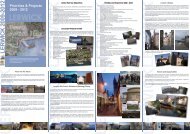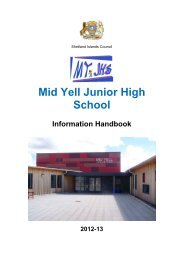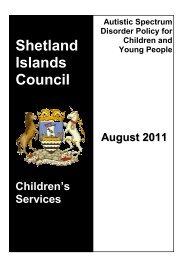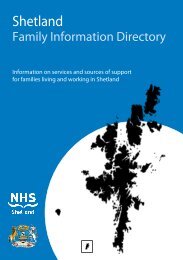Shetland Local Landscape Designation Review: Final Report
Shetland Local Landscape Designation Review: Final Report
Shetland Local Landscape Designation Review: Final Report
Create successful ePaper yourself
Turn your PDF publications into a flip-book with our unique Google optimized e-Paper software.
Candidate <strong>Local</strong> <strong>Landscape</strong> Area 1: Ronas Hill<br />
Location and boundaries:<br />
This area covers Ronas Hill in Northmavine, along with the long, curving Ronas Voe to the south.<br />
It includes the foothills of Ronas Hill stepping down to the sea to the west, and the rocky<br />
moorland to the north and east, as well as both sides of Ronas Voe.<br />
The north boundary of this area follows a chain of lochs and the Burn of Roerwater from the<br />
coast at Lang Clodie Wick to the A970. The eastern boundary follows the A970 as far as<br />
Swinister. The southern boundary runs along the ridgeline to the south of Ronas Voe, including<br />
the visual envelope of the voe. These boundaries enclose the setting of hill and voe, and<br />
represent the most suitable physical and visual boundaries available.<br />
Key characteristics:<br />
<br />
<br />
<br />
<br />
A <strong>Shetland</strong> landmark, the highest point of the islands<br />
Distinctive red granite geology is clearly expressed<br />
Largely empty, uninhabited hills and moors<br />
Rocky plateau, steep cliffs, and other rugged features<br />
<strong>Designation</strong> statement:<br />
Ronas Hill is a <strong>Shetland</strong> landmark, distinctive as the highest point on the islands. It is widely<br />
visible from locations to the south and west, though its true size, relative to the generally lowlying<br />
<strong>Shetland</strong> Islands, is only apparent closer to. The hill has a distinctive red colour derived<br />
from its granite geology. Ronas Hill is the main peak of a broad, rounded ridge running east to<br />
west, and topped by an expansive rocky plateau. This gravelly granite surface features unusual<br />
alpine plant communities, which occur here at exceptionally low altitudes. The plateau falls away<br />
to the north, giving way to lochans and blanket bog. The hill offers wide views across the whole<br />
of <strong>Shetland</strong>, and is a popular destination for hill-walkers visiting <strong>Shetland</strong>. The chambered cairn at<br />
the summit makes for a destination, as well as speaking of the long-established human presence,<br />
even in the remotest parts of <strong>Shetland</strong>. The masts on Collafirth Hill are a reminder of more<br />
modern human influence, but otherwise this is an empty landscape, without settlement except<br />
for properties along the A970.<br />
Ronas Voe to the south is deep and broad, a dramatic fjord-like inlet with tall cliffs of pink granite<br />
and green grass on its northern shore. These colourful cliffs are at their most imposing from<br />
Heylor on the south shore. Falling steeply into the water, their feet are fringed by narrow<br />
reddish ayres derived from the granite. Small burns tumble down incised gullies in the cliffs, and<br />
remnants of willow scrub can be seen. The eastern voe is less dramatic, with disused dwellings<br />
visible on the north shore. The open coastal edge to the west has a steep rugged edge, with<br />
sharp offshore rocks and islets. Rounded bays are gouged out of the granite, eroding onto more<br />
red-tinted beaches. A minor road follows the south shore of the voe, giving access to a very few<br />
dwellings, and emphasising the inaccessibility of the north shore. Otherwise human influence is<br />
limited to fish farms in the voe and associated landings on the coast.<br />
Development guidelines:<br />
<br />
<br />
<br />
<br />
Ronas Hill and the north shore of Ronas Voe should remain an area of very limited human<br />
influence. The further proliferation of infrastructure on Collafirth Hill may lead to visual<br />
clutter<br />
Carefully consider the siting and design of any proposed development along the south shore<br />
of Ronas Voe<br />
Seek to ensure that new and existing fish farms, and particularly the associated onshore<br />
components, can be assimilated into the landscape through design and ongoing maintenance<br />
Encourage sustainable and responsible recreational access into this landscape, to allow<br />
greater appreciation<br />
<strong>Shetland</strong> Islands <strong>Local</strong> <strong>Landscape</strong> <strong>Designation</strong> <strong>Review</strong><br />
Land Use Consultants<br />
<strong>Final</strong> <strong>Report</strong> 54 October 2011
















